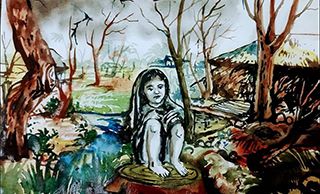Soumya Kundu

"DISASTERS ARE CALLED NATURAL, AS IF NATURE WERE THE EXECUTIONER AND NOT THE VICTIM." EDUARDO GALEANO
The watercolour painting above by Indian artist Soumya Kundu from Kolkata in the state of West Bengal, comes with the tag #How Do You Save a Million People From a Cyclone? Ask a Poor State in India.
As a follower of Soumya's art works and curious about the tag line I did a little research on the topic and found the stimulus for this painting dates back to May 2019 when:
In a stunning success story of government efficiency, over one million people were evacuated to safety in anticipation of the brutal summer cyclone that hit the coast of one of India’s poorest states earlier this week.
Cyclone Fani hit the eastern state of Odisha on Friday with winds roaring at over 120 miles per hour. Though tropical storms are generally associated with devastating death tolls, the state’s emergency responders are being praised for the unprecedented speed of their response.
In a matter of days, government officials, volunteers, emergency workers, and media teams were able to evacuate 1.1 million low-income citizens from about 15,000 villages to shelter before the storm. Not only that, the shelters were stocked with food, water, supplies, and resources. (2)
Follow this link to read the full article by McKinley Corbley A Poor State in India Learned From Its Mistakes: How It Saved a Million People From the Devastating Cyclone
Soumya's tag line comes from The New York Times headlines reporting on the event: How Do You Save a Million People From a Cyclone? Ask a Poor State in India. (2)
You can watch Soumya create his painting with passion and dexterity.
Soumya Kundu lives in Kolkata and I thought you would be interested in learning a little more about this part of India.
Kolkata (also known as Calcutta - the official name until 2001) is the capital of the Indian state of West Bengal. Located on the eastern bank of the Hooghly River, the city is approximately 80 kilometres (50 mi) west of the border with Bangladesh. It is the primary business, commercial, and financial hub of Eastern India and the main port of communication for North-East India. According to the 2011 Indian census, Kolkata is the seventh-most populous city in India, with a population of 4.5 million residents within the city limits, and a population of over 14.1 million residents in the Kolkata Metropolitan Area, making it the third-most populous metropolitan area in India. The Port of Kolkata is India's oldest operating port and its sole major riverine port.
In the late 17th century, the three villages that predated Calcutta were ruled by the Nawab of Bengal under Mughal suzerainty. After the Nawab granted the East India Company a trading licence in 1690, the area was developed by the Company into an increasingly fortified trading post. Nawab Siraj ud-Daulah occupied Calcutta in 1756, and the East India Company retook it the following year. In 1793 the East India company was strong enough to abolish rule, and assumed full sovereignty of the region. Under the company rule and later under the British Raj, Calcutta served as the capital of British-held territories in India until 1911, when its perceived geographical disadvantages, combined with growing nationalism in Bengal, led to a shift of the capital to New Delhi. Calcutta was the centre for the Indian independence movement. Following independence in 1947, Kolkata, which was once the centre of Indian commerce, culture, and politics, suffered many decades of political violence and economic stagnation.
A demographically diverse city, the culture of Kolkata features idiosyncrasies that include distinctively close-knit neighbourhoods (paras) and freestyle conversations (adda). Kolkata is home to West Bengal's film industry Tollywood, and cultural institutions, such as the Academy of Fine Arts, the Victoria Memorial, the Asiatic Society, the Indian Museum and the National Library of India. Among scientific institutions, Kolkata hosts the Agri Horticultural Society of India, the Geological Survey of India, the Botanical Survey of India, the Calcutta Mathematical Society, the Indian Science Congress Association, the Zoological Survey of India, the Institution of Engineers, the Anthropological Survey of India and the Indian Public Health Association. Four Nobel laureates and two Nobel Memorial Prize winners are associated with the city. Though home to major cricketing venues and franchises, Kolkata differs from other Indian cities by focusing on association football and other sports. 3
With thanks
© The creative works shown here are done so with the permission of the artist Soumya Kundu. Thank you Soumya for sharing your works, thoughts and creative journey with the AnArt4Life blog subscribers.
If you are a Facebook user you can follow him at: Soumya Kundu Facebook page.
Credit
1. A Poor State in India Learned From Its Mistakes: How It Saved a Million People From the Devastating Cyclone By McKinley Corbley -May 7, 2019 (goodnewsnetwork.org)
2.nytimes.com
3.en.wikipedia.org
